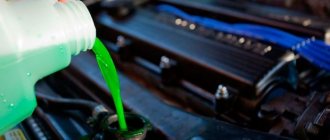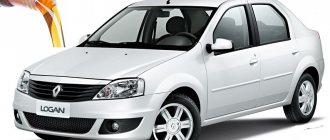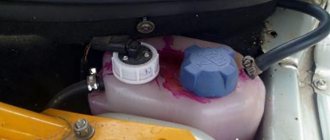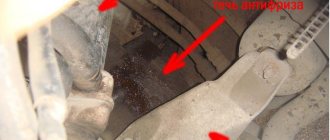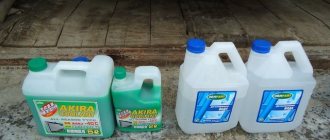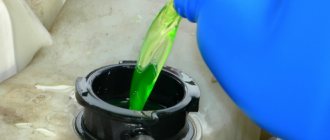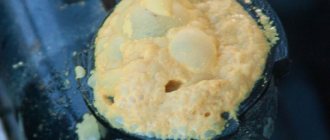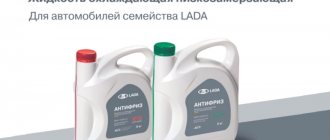Issues discussed in the material:
- What is antifreeze for cars
- What properties do different types of antifreeze have?
- What types of antifreeze are colored blue?
- What is the scope of application of green antifreeze
- What properties do red types of antifreeze have?
- What is the composition of purple antifreeze
Antifreeze is a liquid that does not freeze even at sub-zero temperatures. It is mainly used as a coolant in a car. But thanks to additional additives, antifreeze can be used for anti-corrosion treatment of parts or as a lubricant (for example, for a pump). In the article we will consider the types of antifreeze, their distinctive and similar qualities.
Why does a car need antifreeze?
Coolant for cars is called differently: antifreeze, refrigerant, coolant, abbreviated as coolant. You can also use water; distilled water, which does not leave scale, is especially suitable for these purposes. It is safe, accessible, harmless, and quite heat-intensive.
However, such a coolant freezes at negative temperatures on the thermometer, has a low boiling point, and also has a certain corrosive activity. Therefore, water can only be used in warm periods, adding a package of corrosion inhibitors to it.
A low-freezing liquid called antifreeze can be used year-round. Recently, this particular product has been widely used by car enthusiasts in our country. Antifreeze is a mixture of:
- distilled water,
- non-freezing component,
- additives that reduce the corrosiveness of the first two components.
Important! Ethyl alcohol can also be used as a coolant, but volatility and high cost prevent it from becoming popular among car enthusiasts. Methyl alcohol reacts with aluminum; moreover, it is poisonous and even a small amount is enough to poison a person.
The main function of coolant is to cool the internal combustion engine. This unit is a thermal unit that converts the energy of burning fuel into mechanical energy.
In order for the motor to operate normally, its heating must be maintained within strictly defined limits. For these purposes, cars are equipped with a cooling system - air and liquid. The latter uses forced circulation of coolant.
However, in addition to the task of cooling the power unit, its functions include:
- heating the vehicle interior in the cold season;
- protection of the cooling system from active corrosion processes, as well as scale;
- keeping channels clean;
- extending the service life of some vehicle components.
Coolant for a car must be fluid, have high heat capacity and thermal conductivity, a minimum threshold for the onset of crystallization, a maximum temperature for the onset of boiling, physical and chemical stability. It should not foam and be aggressive (in terms of impact on components and parts of the car).
Different types of antifreeze have differences in composition. There are also nuances in changing the characteristics of different types during operation.
This is interesting: Warming frozen water supply and equipment: methods, methods
Instructions for Renault Glaceol RX
If you need to change the Glaceol RX Type D refrigerant in your car, follow the instructions:
- Park the car over the inspection hole (note that the back of the car should be higher than the front.
- Clean the antifreeze container by draining the old one.
- It is necessary to rinse the refrigerant filling tank using water or detergent (if sediment is found).
- The machine must be in a horizontal position before you add new fluid, remove the tilt.
- Dilute the new refrigerant using distilled water (stick to the ratio: 1 liter of concentrate to 1 liter of water).
- Fill the tank with new fluid.
- Start the engine for 20-25 minutes, leave it until you notice that the fan has turned on.
- When the expiration date has expired, change the refrigerant (you can see the expiration date on the packaging); it must be changed in case of accidents.
How to dilute antifreeze concentrate for a car
Antifreeze for the car cooling system is produced by manufacturers in the form of a concentrate or a ready-to-use product. In the first case, the liquid contains all the necessary additives, an antifreeze component and a dye.
To prepare antifreeze, you only need to add distilled water (mixing can be done in any container). Options for the proportions of water and concentrate to obtain the finished coolant are presented in the table.
Table. Approximate proportions of components for producing antifreeze with different freezing points from concentrate.
| Ratio of water and concentrate, % | Freezing temperature of finished antifreeze, degrees |
| 50/50 | -35 |
| 40/60 | -55 |
| 60/40 | -25 |
Important! It is strictly prohibited to pour undiluted concentrate into the cooling system.
Many people habitually call coolant antifreeze. Some believe that there are two types of product: antifreeze and antifreeze. You should immediately set the record straight: antifreeze is a type of antifreeze developed by domestic specialists back in Soviet times. It can be classified as a first generation coolant.
Interesting! The brand “Tosol” got its name from the abbreviation “TOS”, derived from the name “Technology of Organic Synthesis”. The ending “ol” usually indicates that the liquid is an alcohol.
The product was invented back in 1971, but was not patented. Therefore, many manufacturers today produce their products under this brand.
Articles and release form
- 7711428132 Renault Glaceol RX Type D (concentrate) 1 l;
- 77 11 428 132 Renault Glaceol RX Type D (concentrate) 1 l;
- 7711428133 Renault Glaceol RX Type D (ready liquid) 1 l;
- 77 11 428 133 Renault Glaceol RX Type D (ready liquid) 1 l;
- 7711428129 Renault Glaceol RX Type D (ready liquid) 2 l;
- 77 11 428 129 Renault Glaceol RX Type D (ready liquid) 2 l;
- 7711428130 Renault Glaceol RX Type D (ready liquid) 5 l;
- 77 11 428 130 Renault Glaceol RX Type D (ready liquid) 5 l.
It is possible to sell Renault Glaceol RX Type D under the Nissan brand: Nissan Engine Coolant Type D. This is a complete analogue.
Types of coolant by composition
Coolant for cooling system based on ethylene glycol
The most popular antifreeze among consumers is a mixture based on ethylene glycol. An interesting fact is that ethylene glycol itself, which is a transparent, odorless liquid, begins to boil at 197 degrees and freeze at -12.
However, by adding water, lower crystallization temperatures can be obtained. This property of the solution is explained by the release of ethylene glycol hydrate, which has a low pour point, when mixed with water.
Thus, when ethylene glycol-based antifreeze contains 33% water, the coolant receives a freezing point of -73 degrees. This is the maximum value. As the water content in antifreeze increases, this indicator increases. The most common antifreeze among consumers is that it has a freezing point of about -50 degrees.
What are the characteristics of ethylene glycol-based coolants:
- some increase in volume when the engine is running (by about 7%);
- aggressive effect on some brands of rubber;
- gradual boiling away of water from antifreeze, as a result of which it may be necessary to add it (as the volume of liquid decreases).
It is worth noting that when freezing, antifreeze turns into a mass, the volume of which increases slightly. Therefore, in this case there is no risk of any damage to the engine cooling system.
Antifreeze for the cooling system based on propylene glycol
In addition to ethylene glycol, propylene glycol can be used in antifreeze. It is less toxic, but costs much more. Glycerin is added to some types of coolant.
When and why do you need to replace the coolant?
During vehicle operation, antifreeze goes through multiple cooling and heating cycles, gradually losing its original characteristics. Car manufacturers indicate the frequency of fluid changes in the operating instructions. Depending on the type of coolant and design features, the replacement period is within 75-240 thousand km.
There may be cases when antifreeze will have to be replaced unscheduled:
- cloudiness of the liquid or obvious change in color;
- the formation of sediment or flakes on the surface of the liquid in the expansion tank;
- foam formation during engine operation;
- the appearance of clots in the liquid or general thickening not associated with freezing;
- loss of liquid level as a result of evaporation;
- adding an inappropriate type of antifreeze.
WINTER COOL
This is exactly what antifreeze can be called, because in English this word is translated as “preventing freezing.” In other words, the primary task of antifreeze is to prevent the car’s cooling system from freezing.
Which, however, does not prevent antifreeze from coping with engine cooling. With the same ethylene glycol base as antifreeze, antifreeze differs from it in color. It’s clear from the name on the canister. Moreover, many out of habit call antifreeze antifreeze, and do not even see the difference.
It comes in a yellowish or light orange hue. The numbers on the can mean the same thing as antifreeze - the beginning of the crystallization temperature. That is, the loss of its fluidity. However, antifreeze has such a tricky feature. In cold weather, it turns into a liquid-icy mixture, which, after starting the engine, turns into liquid again and completely retains its original properties. (Of course, we are not talking about a temperature that is lower than indicated on the antifreeze canister.)
It should be remembered that glycol antifreezes have high fluidity. Therefore, special attention is paid to the tightness of connections of all components of the cooling system.
Criteria for choosing antifreeze: briefly about the main thing
- Effective cooling;
- High boiling point;
- Low crystallization;
- Anti-corrosion properties;
- Good heat capacity;
- Environmental friendliness and safety for humans;
- Price.
No self-respecting car enthusiast will choose antifreeze in damaged packaging. Make sure that it indicates the manufacturer’s details, expiration date and manufacture of antifreeze. The liquid should be free of sediment or flakes. Shake the canister: the foam that appears should disappear after 3-4 seconds. If you press on the container, there should be no liquid or air escaping from it.
What types exist
Antifreeze is the general name for all coolants. There is a huge variety of them. Plain water was initially used as a coolant. It was then replaced with a solution of water and salt. The prototype of modern antifreeze was created in 1930. Ethylene glycol began to play a cooling role. Later, various additives were added to it.
Today in the store you can come across a huge variety of antifreeze. They differ in their composition, color and service life.
According to their composition they are:
- silicate;
- carboxylate;
- hybrid.
Each type has its own characteristics and characteristics.
- Silicate compounds contain salts of inorganic acids. They are the main additives for this type of coolant. A negative characteristic of such a liquid is the formation of plaque. Salts form a thin film of plaque over time. It settles and prevents the system from working fully. Which leads to heating of the car engine, consequently, to greater consumption of oil and fuel.
- In the carboxylate type, the acids are organic. This type of antifreeze is designated as follows - G12 or G12+. Organic acids, unlike inorganic acids, do not form scale and plaque. This type can last about 5 years. Carboxylate antifreezes have anti-corrosion and anti-cavitation properties.
- The hybrid type contains both organic and inorganic acids. This type is designated G11. This type combines the positive and negative properties of the two previous types.
A new product among coolants is Lobrid antifreeze - G12++ and G13. It contains an organic base and mineral additives. Thanks to its unique composition, this substance can last up to 100,000 km.
The most common and popular, although not of very high quality, is Traditional antifreeze. Its service life is no more than 2 years. This type cannot withstand high temperatures. It begins to boil at 105 degrees Celsius. Antifreeze is the most famous of Traditional antifreezes.
Antifreezes also differ from each other in color. In fact, the color of a substance is in no way determined by its composition or quality. A specific color is assigned to a specific color ″[/img]
This is interesting: Transportation of dangerous goods: basic rules
How to check antifreeze for freezing?
There are several ways to determine the freezing point of coolant. Let's look at each of them in detail.
First way
To check the coolant freezing point you will need:
- thermometer;
- pharmaceutical syringe;
- cup.
Thermometer for measuring temperature
Syringe for collecting consumables
Regular disposable glass
Let's get started:
- Using a syringe, pump out about 100 grams of coolant from the expansion tank or packaging.
- Pour it into a glass and place it in the freezer. Place a thermometer there along with the consumables.
- Every 3-5 minutes you need to check visually when the coolant begins to become cloudy. At this moment, it is time for crystallization to begin.
- At the moment when the consumable begins to become cloudy, check the coolant temperature with a thermometer.
Second way
A device for measuring the density of a hydrometer in disassembled form.
It consists in the fact that you need to measure the density of the consumable substance using a special device and calculate the temperature at which crystallization begins using a table. A hydrometer can be purchased at any automotive store. The correspondence table is provided below. The test should be carried out in a room with a temperature of 20 degrees Celsius. Wait some time until your consumables reach this temperature.
- Open the cap of your vehicle's expansion tank.
- Take a hydrometer and collect some coolant in it. To do this, lower the pipette into the expansion tank and, using the so-called “bulb”, take out enough coolant so that the float of the device floats freely in it.
- You need to visually determine the coolant concentration using the hydrometer scale.
- Compare the resulting figure with the table below.
Open the hood and unscrew the expansion tank cap.
Insert one end of the hydrometer into the expansion tank and pump the bulb several times to collect coolant.
Take enough consumables so that the float floats freely in the flask.
| Propylene glycol solution | Beginning of coolant crystallization | Density at 20˚C | Ethylene glycol solution | Freezing point | Density at 20˚С |
| 30% | -13˚С | 1,023 | 30% | -15˚С | 1,038 |
| 35% | -20˚С | 1,028 | 35% | -20˚С | 1,045 |
| 40% | -25˚С | 1,032 | 40% | -25˚С | 1,052 |
| 45% | -30˚С | 1,035 | 45% | -30˚С | 1,058 |
| 50% | -35˚С | 1,038 | 50% | -35˚С | 1,064 |
| 55% | -45˚С | 1,040 | 55% | -43˚С | 1,071 |
| 60% | -55˚С | 1,042 | 60% | -50˚С | 1,077 |
| 65% | -60˚С | 1,043 | 65% | -60˚С | 1,083 |
| 70% | -65˚С | 1,044 | 70% | -70˚С | 1,088 |
Remember that all the properties and characteristics of the consumable material are indicated on the canister label. So take a few minutes to familiarize yourself with them so that you don't have any questions later.
Also take time to choose the coolant. Do not buy consumables from untrusted suppliers, dubious car markets or from dealers who stand on the side of the road. Often such sellers sell low-quality coolant, the use of which will not lead to anything good.
Also consider your engine specification. Sometimes antifreeze may simply not suit the characteristics of the engine or cooling system. The requirements of the motor should be taken into account as this is a very important point. It is especially not recommended to fill foreign-made cars with Russian antifreeze. Of course, the technology for its production is being modernized, but initially such consumables were designed for domestic cars.
How is coolant for cars standardized?
In our country, GOST 28084-89 applies to coolants. For foreign-made liquids, there are ASTM and SAE standards, which classify products according to operating conditions and composition.
For example, for cars and small trucks, ASTM D 3306 and ASTM D 4656 are approved. Automobile manufacturers can develop their own standards.
In particular, the Volkswagen concern has a specification TL 774. It is this that is most widely used. Standards G (based on which liquids are classified into varieties G11, G12, G12+, G12++ and G13) are used today by many manufacturers.
Regarding such antifreezes:
G11 contains silicates for corrosion protection. Its average service life is 2 years (maximum three).
Compositions G12 and G12+ do not contain silicates. Their service life is up to five years.
G13 (lobrid) liquids, which appeared not so long ago, contain propylene glycol, as it is more modern and less toxic. The additives in them are the same as in the products of the previous generation.
Blue color or our TOSOL
I will talk specifically about the 20% that is added to the ethylene glycol + water compositions. I’ll be the first to tell you about our antifreeze or TOSOL. It won’t get into the wilds, I’ll just say one thing, not all of it is painted blue, there are also options with red color. The only differences between them are the temperature threshold:
Blue antifreeze holds from “-30” to “-40” (maximum)
Red is already up to “-65” (also the maximum, but the operating temperature is approximately “-50”)
These are the so-called first generation or “traditional” additives. They are made on the basis of such compounds as silicates, phosphates, borates, nitrites, etc. – these are inorganic compounds, in simple words “chemistry”. Protection of pipes and pipes occurs by forming protective “thin” films on parts of cooling systems (pipes, tubes, radiators, etc.). For its time, it was a breakthrough in technology, but now it is obsolete. The main disadvantages are:
- Their service life is two to three years, after which their abilities decline.
- At temperatures of 110 - 115 degrees Celsius they boil.
It is recommended to completely change it every three years! Why don't they use it on foreign cars? Because this composition is the most active of all, if our cars can still carry it, then some foreign cars with it won’t even start (more on that a little later). YES, and some foreign cars have “high-temperature” engines - that is, they operate at 110 degrees Celsius, and not at 90 - 100; antifreeze can simply boil. It’s not worth pouring into a foreign car, after all, the tolerances and materials are different.
What are the properties of different types of antifreeze
When choosing antifreeze, you should understand that its function is not only to cool the engine. Other properties depend on the additive added to it. This will be the main answer to the question: which antifreeze is better to choose for your car?
Corrosion.
Depending on the proportions of water and ethylene glycol, the freezing point of the liquid varies. But this liquid in its “pure” form will be quite aggressive towards engine metals. Aggression means the appearance of rust. Corrosion will be more noticeable due to the fact that in the production of current engines light alloy metals are used, in which corrosion processes occur more quickly. Therefore, the anti-corrosion properties of additives are one of the main tasks of antifreeze manufacturers.
Freezing temperature.
Since the freezing point of antifreeze is an order of magnitude lower than that of water, a car engine can operate even at extremely low temperatures. This also avoids rupture of parts of the cooling system in winter, which is quite possible when the system is filled with water, which expands when freezing. If it freezes, the antifreeze becomes a porridge-like mass, leaving engine parts intact. True, the engine will not be able to operate in such conditions.
Boiling temperature.
Antifreeze has a fairly high boiling point threshold, which ensures normal engine operation even in the hottest weather.
Cavitation.
During engine operation, antifreeze receives (through the block head and the block itself) high-frequency vibrations. This causes the liquid to “boil”, which leads to the appearance of bubbles on the surface, which immediately burst. This boiling process is called cavitation. In this state, antifreeze gradually destroys the protective layer of the additive, corroding (along with corrosion) the metal parts of the engine. It is worth noting that even a thin protective layer of lobride and carboxylate antifreezes resists cavitation much more effectively than a massive layer of deposits formed from the use of classical and hybrid products.
Foamability.
To maintain the heat transfer coefficient, the antifreeze should not foam too much. Otherwise, steam and air pockets may appear, which will lead to overheating of the engine.
Impact on rubber.
Various types of antifreeze must be inert to engine parts made of rubber and polymers (seals, hoses and plastic parts). Antifreeze, in addition to its main function, is designed to protect such elements from drying out. In normal mode, the rubber, interacting with the coolant, swells a little.
A few words about “Tosol”
Now about “Antifreeze”. Almost all of the coolants we produce are called this way. In fact, “Tosol” is just one type of antifreeze.
This liquid was developed at the Research Institute of Organic Chemistry and Technologies, Department of Organic Synthesis Technology. The abbreviation of this department formed the basis of the word for liquid. The prefix -Ol in the name, according to one version, means alcohol. Hence the name – “Tosol”.
"Tosol" is an ethylene glycol solution with the addition of a traditional inhibitor. It is still produced now, and in two types - “Tosol 40” and “Tosol 65”. The digital designation indicates the freezing point of a given liquid.
Additionally, they differ in color - “Tosol 40” has a blue tint, while the more frost-resistant liquid has a red tint.
In general, “Tosol,” developed in the USSR, has long been outdated, but the very name of the coolant is so firmly rooted in the vocabulary that it is applicable to all liquids for the cooling system.
According to the composition used in the work, antifreezes are divided into
- carboxylate;
- silicate;
- hybrid.
All of the above types of antifreeze have certain features for use and differ from each other in many properties. For example, silicate types of engine antifreeze contain a lot of inorganic acid. This type of antifreeze is the most popular in use and has many additives.
- The negative component of this type of cooling mixture is the tendency for plaque to appear. Further, as such antifreeze is used, the salts in its composition create a neat film of plaque, which can settle and does not allow the engine to operate stably. This provokes excessive heating of the car engine, and also leads to even greater consumption of lubricant and gasoline by the engine.
- Carboxylate types of antifreeze have excellent anti-corrosion and anti-cavitation characteristics.
- Hybrid types of antifreeze contain both various organic and various inorganic types of acids. This type of antifreeze is designated G11. This type of antifreeze combines both negative and positive characteristics of the two types of antifreeze described earlier.
- New to the list among all cooling antifreezes can be called lobrid antifreeze - G12 plus and the latest antifreeze G13. It contains a natural base and numerous additives. Thanks to its thoughtful composition, this mixture can last up to 100 thousand kilometers.
- The most famous and at the same time affordable, but still not particularly high-quality, is the classic cooling mixture. Her service time is no more than two years. This type of cooling mixture is not able to withstand the maximum operating temperature and goes into the boiling phase at 105 degrees.
Red antifreeze or G12
Even more advanced antifreezes appeared immediately after green. The additives needed are almost completely organic, that is, carboxylic acid is used in large quantities.
These additives do not form a film inside the pipes, which significantly improves heat dissipation. They perfectly localize corrosion spots, forming a 1 micron thick film on them. They also do not crumble after a certain time. These additives are much more advanced than, say, the previous generation.
Pros:
- Improved heat dissipation
- Do not crumble
- Long lasting, service life up to 5 years
- Excellent localization of corrosion areas
Minuses:
- It seems that this is happiness - the additives are ideal, but there is one minus, and a significant one. They begin to fight pockets of corrosion, but do not protect or prevent the cooling system. This is a huge disadvantage of red antifreeze.
- Also, carboxylic acid does not protect aluminum radiators much, which also has a negative connotation; however, they protect copper and brass more strongly.
What is “ G12 +” and “ G12 + +”?
If you want, this is a hybrid, to exaggerate it is similar to “G11” - only here there is a smaller part of chemical reagents, for example silicates, but there are more organics (carboxylic acid). That is, if the additive itself is broken down into its components, you get 80 - 90% carboxylic acid and 10 - 20% silicates.
Color Differences
Antifreezes may differ in shade, but the color itself is not determined by the components included in the composition or the quality of the resulting mixture. A certain shade is rather assigned to each manufacturer.
What are the main considerations that are important to follow when creating mixtures between two or more antifreezes? At this point you can write at least a few simple recommendations:
- Without fear, you can mix different antifreezes that have a common base and components that meet established quality standards. However, the characteristics of such a liquid are very often not written by the company, and therefore the buyer only has to follow the instructions on the packaging.
- Different types of mixtures (with artificial and natural additives) can only be mixed if specified by the manufacturer.
Keep in mind that the incompatibility of cooling mixtures lies in the likelihood of a reaction between the additives included in the composition. This may negatively affect the operation of the motor.
Which antifreeze to choose
It is obvious that coolants, although made on the same base - ethylene glycol, can differ radically in the composition of additives. It is absolutely not worth mixing them, as well as experimenting with fashionable new products on the market that are not intended for your engine. Therefore, to the question “what antifreeze to pour into the engine” there is only one correct answer: the one recommended by the manufacturer. Carefully read the car's instructions, find the prescribed type of antifreeze and fill only that.
Where are green types of antifreeze used (G11)
Green antifreeze (or G11) is a more technologically advanced liquid compared to antifreeze. Although some manufacturers produce this product in yellow (and sometimes blue), the main standard is supported by industry leaders, which is why antifreeze is produced in green.
Unlike the previous generation, G11 also uses organic compounds (carboxylic acid), although in small quantities. But the basic composition is almost the same as in the first generation antifreeze: silicates, phosphates and borates. The advantage of this combination of components is that the mixture quite effectively resists corrosion (which is largely due to carboxylic acid) and envelops the internal walls of the car’s cooling system.
Advantages:
- During operation, all internal parts are covered with a protective film.
- The likelihood of corrosion is significantly reduced.
Flaws:
- Insufficient heat removal (consequence of film formation on the internal walls of the cooling system).
- After some time, the adhering antifreeze particles fall off and enter the system, clogging small channels.
- Requires mandatory replacement once every 2-3 years.
Green antifreeze is also usually separated by markings G11 and G12. The only difference between them is the concentration of carboxylic acid. The higher its content, the closer the antifreeze model is to the G12 marking. Although it didn’t really take root in Russia.
How to add antifreeze correctly
Filling your system with antifreeze is not a very difficult technical task, but it can be dangerous. The reservoir that holds the antifreeze when it cools is under pressure, so it can be dangerous if you don't take the proper precautions.
Whenever you work with chemical liquids you should wear safety glasses to protect your eyes from any chemicals. Follow these steps to add antifreeze to your vehicle's system.
Why do you need to replace antifreeze on a regular basis?
A lot here depends on the fact that any automobile antifreeze or antifreeze changes its properties over time and becomes unusable, but if you would not like the car’s cooling system to corrode over time, change the antifreeze regularly.
- Typically, automotive antifreeze is sold in a concentrated composition, which, before you start opening it for pouring into the car’s cooling system, should be mixed with purified water in a ratio of 50 to 50. However, this concentration of mixing water and coolant may undergo certain changes depending on the how you will use your car.
- It is worth considering that in the northern part of the country, where in the winter months there is usually a minimum temperature outside, the ratio of the amount of water to cooling. the mixture should be brought to the very minimum level.
- Antifreeze for cooling can be poured even in a concentrated state. A lot here depends on what temperature outside you decide to drive your car at. Remember that the more antifreeze you add, the greater the freezing point of the mixture.
Frequently asked questions
Antifreeze or antifreeze?
Video: Antifreeze or antifreeze: which is better to use and pour into your car? Just something complicated
Among motorists, the question often arises as to what is better - antifreeze or antifreeze? In general, there is no difference, since both names mean car coolant. Antifreeze is a domestically produced liquid, and it is counterfeited much more often.
Is color scheme important? And is it possible to mix liquids of different colors?
It is worth noting that antifreeze and antifreeze themselves are colorless, and the choice of shade depends entirely on the manufacturer. The dye itself is added in an extremely small amount, so it has no effect on the performance characteristics of the liquid. This means that you should not mix different liquids. The exception is the presence on the label of information about the approval of mixing this antifreeze with others.
When to change antifreeze?
Many automakers fill in antifreeze for the entire service life, which is indicated in the manual for the model. Although companies give their own recommendations on timing:
- Volkswagen – indefinitely;
- General Motors - indefinitely;
- Renault – indefinitely;
- Mitsubishi – 4 years;
- Ford – 240,000 km or 10 years;
- Mercedes-Benz – 5 years;
- AvtoVAZ - 75,000 km;
- Mazda – indefinitely;
- Daimler – 15 years;
- BMW – 4 years.
However, when buying a used car, the antifreeze must be replaced. Read how to replace the coolant
In this article
.
Is it possible to mix different types of antifreeze?
The first point when choosing antifreeze should be the recommendation from the specification for the car. If the car has already been used, it would not hurt to ask the previous owner about the brand of coolant used for the cooling system.
Even if you have to mix different types of antifreeze, you should adhere to certain standards. It is allowed to use products from different manufacturers, but of the appropriate brand and proper quality. When using a mixture marked G13 in a car, it should also be supplemented with a mixture of the specified class.
You can combine different types of antifreeze (by color), provided that they belong to the same class. That is, it is allowed to add blue liquid with the same marking to green antifreeze marked G11. In red antifreeze you can safely add antifreeze with a blue tint, and in violet-colored G13 antifreeze you can add liquid of the same class, but already orange.
The main thing is to understand the principle of compliance of antifreeze labels. G11 and G12 brand models contain ethylene glycol, while G13 antifreeze uses propylene glycol. These are completely different alcohol compounds that are not compatible with each other. You can also remember the color variations of combining different types of antifreeze: yellow liquid cannot be mixed with green or red, and red antifreeze with orange or purple.
If you mix antifreeze G12 (red) with green G11, then there is (albeit a small) risk for use in radiators made of aluminum alloys (they may not be protected from corrosion).
But if you swap them, that is, add red G12 liquid to the G11 antifreeze, then nothing bad will happen. True, the efficiency of heat removal may decrease over time, since the resulting film will precipitate.
But even in the case of acceptable color combinations of different types of antifreeze, it is worth selecting a liquid with a list of additives that will match your car and its intended use. It happens that different brands of coolant containing different additives are not compatible with each other, and such use can lead to dire consequences. If you were forced to mix untested combinations of antifreeze, then it is worth making a complete fluid change when the opportunity arises.
In general, color is not the main principle of antifreeze selection. More attention should be paid to the tolerance class, which is indicated in the marking. This is due to the fact that manufacturers may have different proportions of additives, sometimes incompatible with each other.
For example, corrosion inhibitors are found in all liquids. But for some, this role is played by carboxylic acid, while for others, phosphates and silicates. When adding one such antifreeze to another, a reaction will occur, resulting in the formation of sediment in the form of flakes, which will make the mixture completely ineffective. That is why, when adding one liquid to another, study their chemical composition.
How to choose a good antifreeze
As already mentioned, it is important to understand that antifreeze is a consumable, that is, it must be periodically replaced. The fact is that over time, the additives in its composition decompose, contaminants accumulate in the liquid, a loss of properties occurs, etc.
To ensure that the channels of the cooling system remain clean, the pump impeller is not destroyed, and the pipes, seals and seals remain in working order, it is necessary to regularly change the coolant.
It would seem that there should be no problems with the choice of antifreeze. It is enough to buy the latest generation (such as G12+ or G13) and, to be on the safe side, replace the antifreeze once every 2-3 years. Of course, this approach will be the most correct, but in reality, not every car owner is ready to make frequent replacements and spend money on expensive good quality antifreeze.
For this reason, it is better not to go to extremes (both not changing the antifreeze at all, and, conversely, making frequent changes). You should approach the issue rationally. In other words, you need to consider if antifreeze is selected, for what (in which car) and under what conditions the coolant will be used, as well as how often it will be changed.
Only taking into account individual factors can we say for sure which good antifreeze will be best for a particular car. First of all, when choosing antifreeze, you should not rely only on the color of the liquid. The reason is that the antifreeze itself is colorless, but dyes are added to it so that if there is a leak, you can understand that it is the cooling system that is leaking.
At the same time, the manufacturers themselves, of which there are a lot (for example, Shell, Liqui Moly, Bizol) are not obliged by any standard to paint this or that type of liquid strictly in a certain color. It turns out that the product of one manufacturer may be red, while the analogue of the second is yellow, etc.
It is also important to understand that mixing incompatible fluids can cause serious consequences in the form of sediment in the cooling system. To avoid problems, the first thing you need to do is study the features of a particular liquid, as well as the classification.
We also add that not all cars can be safely filled with any antifreeze that comes along. The fact is that radiators and other elements can be made of different materials, which makes the use of certain liquids in the cooling system undesirable. Let's figure it out.
- Above we have already looked at what types of antifreeze there are. At the same time, the most common antifreeze, where the base is ethylene glycol, to which additives are also added. This concentrate is mixed with distilled water.
So, to ensure that aggressive ethylene glycol causes corrosion to a minimum and comes into contact with the tubes in the lines, protective additives in the form of carboxylic acid fight rust, and silicates form a special layer on the walls, preventing direct contact. However, after 2 years, the layer from the walls simply precipitates. Often this applies to G11 antifreeze.
We also recommend reading the article about how antifreeze differs from antifreeze, whether it is possible to mix antifreeze and antifreeze, etc. From this article you will learn about the main features and differences of these types of coolants, as well as what is better, antifreeze or antifreeze.
In turn, antifreezes G12 and G12+ do not contain silicates, but they have an increased content of carboxylic acid to combat corrosion. In this case, no protective layer is formed on the walls; the liquid slows down corrosion only where it has already begun.
On the one hand, the disadvantage is that there is less protection from the inside, stronger oxidation and cavitation occurs, but the advantages are better heat transfer and an increased service life (up to 3-4 years) when compared with G11.
In turn, G12++ is a hybrid antifreeze that contains both carboxylic acid and silicates, but the amount of silicates is kept to a minimum (no more than 15%). This antifreeze forms a fairly thin layer on the walls and quickly neutralizes oxidizing agents, but the heat dissipation of the liquid is somewhat worse than that of G12+.
Finally, G13 antifreeze is similar in properties to G12++, but is noticeably more expensive due to the fact that it is made from less toxic polypropylene. It is also noted that its effect on the components and parts of the cooling system is more gentle, however, the disadvantage is the high cost of the product.
Now we will answer the question of how best to pour antifreeze into a car. First of all, which is recommended according to the manual. However, if the car was manufactured several years ago, the information may well be out of date.
In this case, the general rules are:
- Green G11 antifreeze is poured into systems with aluminum parts (radiators, pipes, etc.), since aluminum tends to oxidize faster and needs better protection. Such antifreeze is replaced every 24 months or 50 thousand km. mileage
- Antifreeze red G12, as well as pink G12+ and G12++ are suitable for systems with parts made of copper and brass, but if aluminum parts predominate, then it is better to use G12++. Replacement is performed every 3-4 years or 80-100 thousand km. mileage
- Yellow antifreeze G13 is universal, it can be poured into any system. It also has an extended service life; this fluid needs to be changed every 5 years.
Finally, we note that it is not recommended to pour Antifreeze into foreign cars, since this analogue of antifreeze contains silicates, phosphates, borates and other solutions that may not be suitable for the cooling systems of modern cars. It is also prohibited to mix antifreeze and antifreeze; it is highly undesirable or prohibited to mix different generations of antifreeze with each other.
If it is not known in advance what kind of liquid is poured into the cooling system, it is recommended to completely flush the engine cooling system before replacing it. It is also necessary to rinse if you switch from one type of antifreeze to another, since the residues in the system can mix with the previously filled fresh coolant.
Antifreeze additives
As has already become clear, the main components of antifreeze are the antifreeze component and water. In principle, this solution has the necessary characteristics: it has a high boiling point, the composition does not freeze in the cold. It would seem, why is it necessary to add additives to it?
In fact, if you pour a mixture of ethylene glycol (propylene glycol) and water into a car, which is quite aggressive, after a while you can get destroyed parts made of metal and rubber. To reduce the activity of antifreeze, it is necessary to add components to the liquid that suppress corrosion processes and other unpleasant phenomena.
All concentrated and pre-diluted antifreezes consist of:
- ethylene glycol or propylene glycol,
- water,
- corrosion inhibitors,
- dye,
- antifoam additive.
- silicate;
- carboxylate.
Substances in the first group are additives based on inorganic elements. Most often, the manufacturer who uses them adds a green or blue dye to the composition.
The second category includes additives made on the basis of organic acids. As a rule, antifreeze with such additives has a red tint.
What effect do additives have? When antifreeze is poured, they form a thin layer on the surface of materials in contact with the liquid that is resistant to corrosion. It protects parts from destruction.
Carboxylate additives look more preferable. This is because inorganic elements can accumulate and clog the channels. While carboxylate inhibitors do not clog the cooling system. In addition, they have a longer service life.
If silicate liquid (antifreeze belongs to this category) loses its performance characteristics after about 60 thousand kilometers, then a carboxylate product from a trusted manufacturer can last four times longer. This composition also removes heat better.
Important! Silicate antifreezes are prohibited for use by many leading car manufacturers.
How to understand that it is original
When purchasing Glaceol RX Type D antifreeze from Renault, you may fall for a fake.
If you want to get around this situation, pay attention to certain details - what condition the container is in, what the label is, whether there is sediment in the canister.
What color is Renault Glaceol RX Type D fluid? Should be yellow-green in color.
The original is produced in canisters made of plastic, which is durable; the liquid is ready for use, diluted with water.
The text must be readable. Code for concentrated liquid (1 l) - 7711428132, diluted (1 l) - 7711428133, (2 l) - 77 11 428 129, (5 l) - 77 11 428 130.
Features and Cautions
There is always a need to top up the coolant. To do this, you should purchase new antifreeze of the same type that is already poured into the car. You should be careful not to mix different types of liquids, even if they are the same color. It is strictly forbidden to mix G12 and G11 antifreezes. They are incompatible.
G12+ fluids can be mixed with two other types.
It is not recommended to add water to antifreeze, especially in the cold season. These liquids can only be mixed for a short time. After some time, it is imperative to drain the entire mixture and add antifreeze. It should be remembered that adding water significantly reduces the freezing and boiling point of the mixture. Protective properties are also lost.
INFLUENCE OF ANTIFREEZE ON ENGINE OVERHEATING
The boiling point of antifreeze is at least 105°C. This is if the coolant meets all standards and GOSTs. It happens that manufacturers try to save money on products and, instead of expensive ethylene glycol, add cheaper glycerin, which costs pennies. However, glycerin-based antifreeze becomes viscous, and as a result, the engine may overheat.
To prevent this antifreeze with glycerin from freezing at -25°C instead of ethylene glycol, manufacturers add methanol, which significantly reduces the freezing point. At the same time, the boiling point of methanol is only 65.5°C. And at higher temperatures, methanol begins to actively evaporate and reduces the boiling point of the coolant to 85-90°C instead of the required 105-108°C.
Leaks of low-quality antifreeze lead not only to engine overheating, but also to fire. If methanol gets on, for example, a hot collector, open combustion may occur .
Not always, the addition of glycerin to the composition indicates low-quality antifreeze. For example, the Volkswagen company, when producing coolants labeled G13, adds a small percentage (up to 20% in concentrate) of glycerin to the composition. This is done not for the sake of savings, but for the sake of the environment. After all, glycerin is a by-product in the production of biodiesel, which means it needs to be put somewhere - for example, used in antifreeze.
We advise you to purchase antifreeze at branded points of sale or through official suppliers in online stores. One way to protect yourself from trouble is to purchase only those products that have good reviews and the manufacturer has a positive reputation. You should not save on antifreeze, because you may also get low-quality goods in the store.
How to start a car in cold weather: tips and solutions
How and with what to flush the engine cooling system.
Flushing the engine cooling system: description, flushing methods.
Engine cooling fan: types, diagnostics, purpose, device.
Why change antifreeze
If the cooling system is working normally, the engine does not overheat, no temperature surges have been noticed, and the stove is functioning properly and efficiently, the question of replacing antifreeze in this case is questioned by many.
To put it simply, many do not see the point in replacing it and do not understand what will happen if the antifreeze is not changed. In practice, this is a big mistake. First of all, the coolant heats up and cools down, and also constantly circulates through the engine cooling jacket, passes through the radiator, etc.
Various metals come into contact with such a liquid. At the same time, active additives in antifreeze work together, which leads to corrosion, the formation of plaque and deposits. It is quite obvious that if the antifreeze is not changed, the accumulation of plaque gradually clogs the narrow channels, rust destroys the parts, and the coolant itself loses its properties.
As a result, the coolant circulation is disrupted, the tubes of the main radiator and the heater radiator (stove) become clogged. In this case, the motor may overheat, and this is not always clearly noticeable, but this still does not add resource to the unit.
The stove may also heat up worse, the pump will break down faster, the thermostat will stop working properly, etc. Eventually the cooling system stops working properly and leaks often appear.
Naturally, in order to avoid such problems and premature repair of the cooling system, it is better to change the antifreeze in a timely manner, using fluids suitable for a particular vehicle.
Why does antifreeze change color during use?
During vehicle operation, the color of the antifreeze may become brown or brown. This is due to scale and rust formed on the parts of the cooling system. This effect most often occurs when water is added to the coolant or a low-quality product is added.
In particular, if you do not flush an engine cooling system that has been running on water or insufficiently high-quality antifreeze, the liquid will definitely change color. The speed of this phenomenon depends on the mileage and time of operation with new antifreeze, the amount of scale and pockets of corrosion in the cooling system.
Freshly poured liquid will begin the process of cleaning the cooling system (due to the presence of various additives in its composition), which will lead to a change in the color of the antifreeze.
The rate of color change also depends on the thickness of the deposit layer in the system.
After detecting that the coolant is colored in the specified colors, you should stop using the car until the antifreeze is completely replaced.
If the antifreeze takes on a straw-yellow hue or becomes slightly discolored, this may indicate dye production or other reasons (for example, engine overheating). You can use the car in such cases, but it still won’t hurt to replace the antifreeze.
Renault Glaceol RX Type D: characteristics
Antifreeze is an original product from Renault. The composition does not include ethyl alcohol.
Green liquid. Antifreeze is safe to use because, thanks to its modern formula, the liquid does not damage parts and prevents rust from appearing on surfaces.
In addition, the refrigerant does not destroy rubber gaskets or dissolve the car's paint.
After testing, it is known that the liquid retains its state of aggregation down to -37°C if the concentrate is correctly related to distilled water, namely: 1:1.
Is it possible to mix antifreezes?
Color does not affect whether mixing is acceptable or not. You can only mix antifreezes of the same composition and class. Even if one is blue and the other is yellow. The main criterion for the compatibility of two liquids: a set of additives. Do not pour silicate or phosphate antifreeze into a liquid containing carboxylic acid. A chemical reaction will occur and the cooling system will become clogged with flakes and sediment. I'll have to go to a car service to wash it!
It is recommended not to add antifreeze with a new composition of a different brand, but to completely replace the old fluid with a new one.
What color are antifreezes?
Antifreezes red, green, blue and yellow
All coolants also contain a dye. What color is antifreeze? The most commonly used are red, green, blue dyes and their shades - that is, blue, crimson, pink, light green, turquoise. There is also yellow, orange, violet, and with them lilac, lilac, yellow-green, red-orange.
Since there are no standards regulating the color of coolant, everything depends on the manufacturer’s imagination. What does the color of antifreeze mean, and what is coloring used for? Read on.
What does the color of antifreeze mean?
Antifreeze of different colors on store shelves Answering the question posed in the title, we can confidently answer: absolutely nothing. It’s just that the manufacturer likes this or that shade, so he uses it to color products. However, there are many misconceptions surrounding this topic, which means that not everything is so simple. So, let's try to figure it out: antifreeze is red, green, blue - what's the difference?
conclusions
And now conclusions in the form of common questions and answers:
- Antifreeze red, green, blue - what is the difference between them? Most manufacturers color liquids of different standards in different colors.
- Can you mix different colors of antifreeze? It is possible if they are made using the same technology.
- Is it possible to mix red and green antifreeze? It is possible if they are both carboxylate or traditional.
- What does the color of antifreeze affect? The dye itself does not affect anything and does not change the properties of the liquid in any way.
- What colors of antifreeze can be mixed with each other? You need to mix liquids based on production technology, not color.
- The antifreeze has turned rusty, what is the reason? A change in color may indicate poor quality, mixing it with unsuitable coolant, or a problem with the cooling system.
Let's hope that this article will dispel motorists' doubts about colors and help them make the right choice!
Antifreeze red - green - blue. What is the difference? Just something complicated
